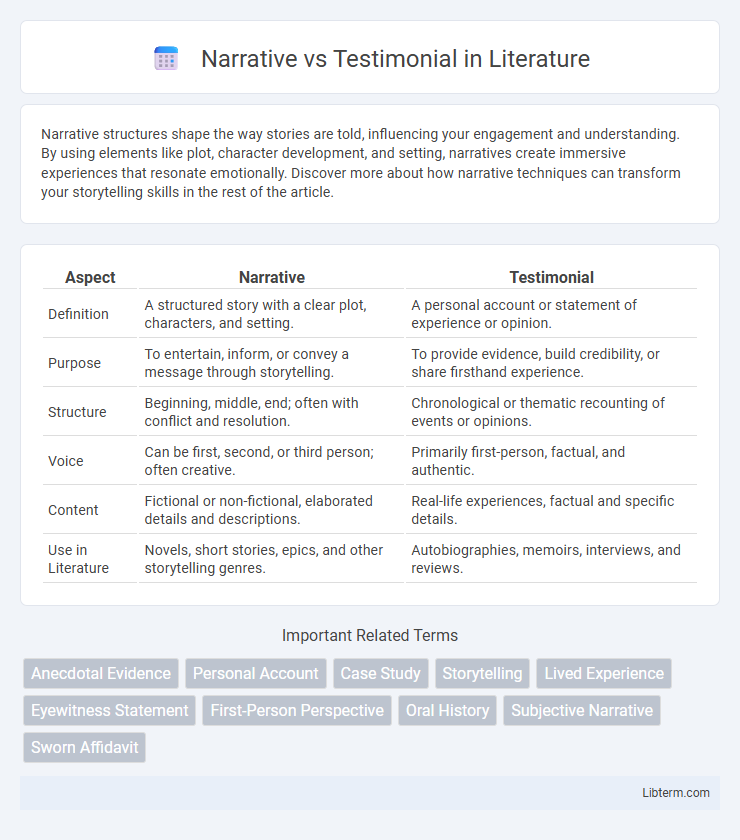Narrative structures shape the way stories are told, influencing your engagement and understanding. By using elements like plot, character development, and setting, narratives create immersive experiences that resonate emotionally. Discover more about how narrative techniques can transform your storytelling skills in the rest of the article.
Table of Comparison
| Aspect | Narrative | Testimonial |
|---|---|---|
| Definition | A structured story with a clear plot, characters, and setting. | A personal account or statement of experience or opinion. |
| Purpose | To entertain, inform, or convey a message through storytelling. | To provide evidence, build credibility, or share firsthand experience. |
| Structure | Beginning, middle, end; often with conflict and resolution. | Chronological or thematic recounting of events or opinions. |
| Voice | Can be first, second, or third person; often creative. | Primarily first-person, factual, and authentic. |
| Content | Fictional or non-fictional, elaborated details and descriptions. | Real-life experiences, factual and specific details. |
| Use in Literature | Novels, short stories, epics, and other storytelling genres. | Autobiographies, memoirs, interviews, and reviews. |
Understanding Narrative and Testimonial
Narrative and testimonial are distinct forms of communication that convey information and experiences differently. Narrative involves a structured story with a clear beginning, middle, and end, emphasizing plot, characters, and context to engage the audience. Testimonial consists of personal endorsements or firsthand accounts, highlighting individual experiences and credibility to build trust and authenticity.
Defining Narrative in Communication
Narrative in communication refers to the structured storytelling method that conveys experiences, events, or ideas through a coherent sequence, often involving characters and a plot. It engages audiences by creating emotional connections and facilitating memory retention, making complex information more relatable and understandable. Unlike testimonials, which rely on personal endorsements or opinions, narratives emphasize the chronological and thematic development of a story to communicate a message effectively.
What Is a Testimonial?
A testimonial is a firsthand account or endorsement from a customer or client that highlights their positive experience with a product, service, or brand. It serves as credible social proof by sharing authentic feedback, often emphasizing specific benefits and outcomes. Businesses leverage testimonials to build trust, enhance reputation, and influence potential buyers' purchasing decisions.
Key Differences Between Narratives and Testimonials
Narratives are structured stories that convey a sequence of events with characters, settings, and a plot, aiming to engage readers through detailed descriptions and emotional depth. Testimonials are concise endorsements or evaluations from previous users or clients, emphasizing credibility, personal experience, and specific benefits related to a product or service. While narratives build immersive experiences, testimonials provide direct social proof to influence decision-making and trust.
Psychological Impact: Narrative vs Testimonial
Narratives engage emotions by creating immersive, relatable stories that enhance memory retention and empathy, fostering a stronger psychological connection with the audience. Testimonials leverage social proof, triggering trust and credibility through real-life experiences shared by individuals, which can reduce skepticism and increase persuasion. Combining both narrative and testimonial elements intensifies emotional resonance and perceived authenticity, leading to more impactful psychological influence on behavior and decision-making.
Effectiveness in Marketing: Which Works Better?
Narrative marketing leverages storytelling to create emotional connections, enhancing brand recall and customer engagement by weaving relatable experiences and brand values into a cohesive story. Testimonial marketing provides authentic social proof through customer endorsements, boosting trust and credibility by showcasing real-life satisfaction and tangible results. Effectiveness depends on the target audience and campaign goals, with narratives excelling in brand-building and testimonials driving conversion through peer validation.
When to Use a Narrative Approach
Use a narrative approach when aiming to engage audiences through storytelling that evokes emotions, making complex information relatable and memorable. This method is ideal for marketing campaigns, brand storytelling, or educational content where personal experiences and detailed scenarios enhance understanding. Narratives foster deeper connections by illustrating real-life applications and consequences, improving audience retention and trust.
When Testimonials Make Sense
Testimonials make sense when businesses need to build trust by showcasing authentic customer experiences that highlight product benefits and satisfaction. They are especially effective in industries like healthcare, real estate, and professional services, where potential clients seek proof of reliability and results from real people. Leveraging detailed testimonials with specific outcomes enhances credibility and encourages decision-making faster than generic narratives.
Combining Narrative and Testimonial Strategies
Combining narrative and testimonial strategies enhances marketing impact by merging emotional storytelling with authentic customer experiences. Narratives create engaging story arcs that resonate with audiences, while testimonials provide credible social proof, boosting trust and conversion rates. This integrated approach leverages the persuasive power of both storytelling and real-world validation to effectively influence consumer decisions.
Crafting Compelling Stories and Testimonials
Crafting compelling stories involves creating vivid narratives that engage emotions and paint relatable scenarios, making the message memorable. Testimonials rely on authentic, specific experiences and credible voices to build trust and validate claims effectively. Combining narrative techniques with genuine testimonials enhances persuasion by blending emotional appeal with evidence-based credibility.
Narrative Infographic

 libterm.com
libterm.com